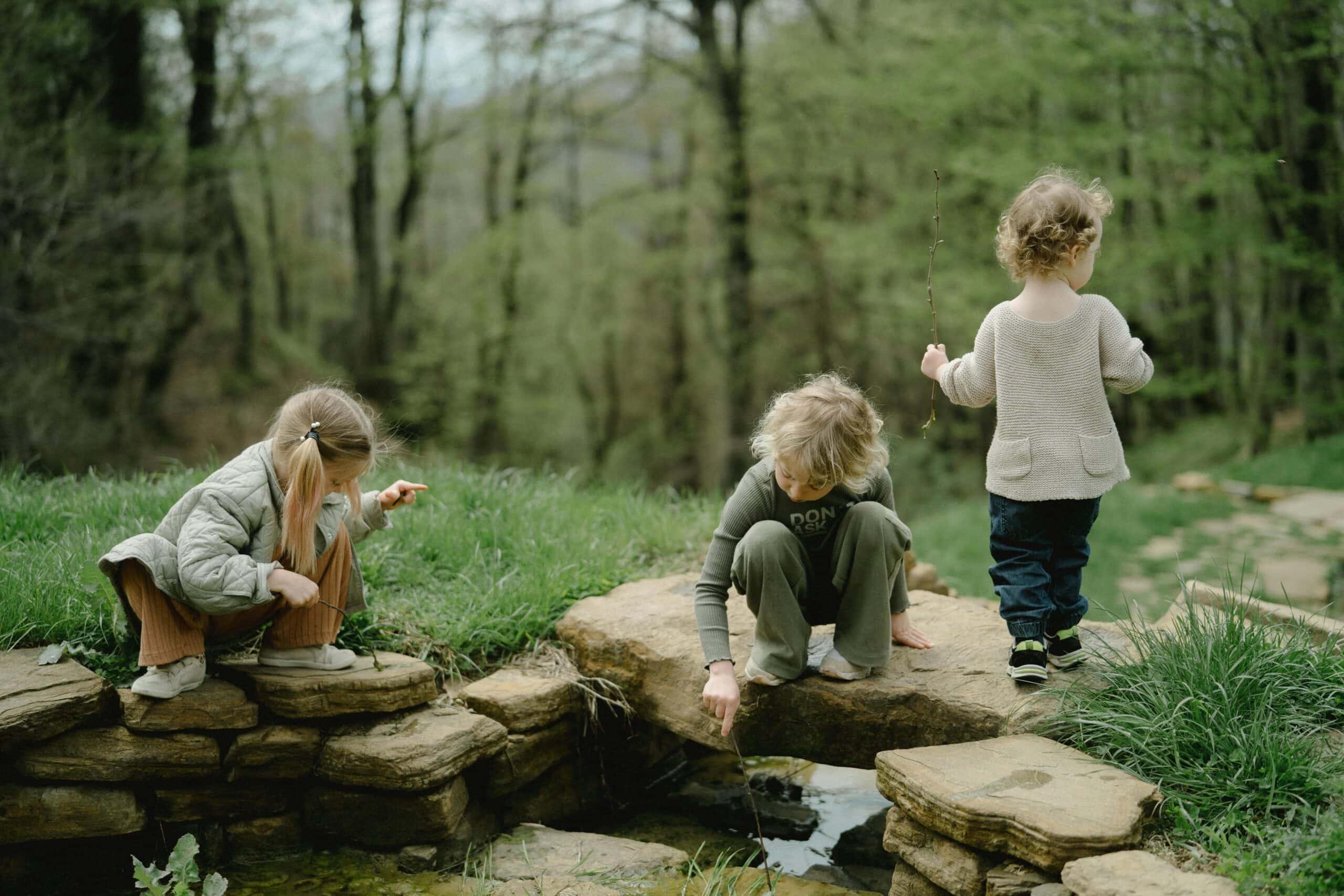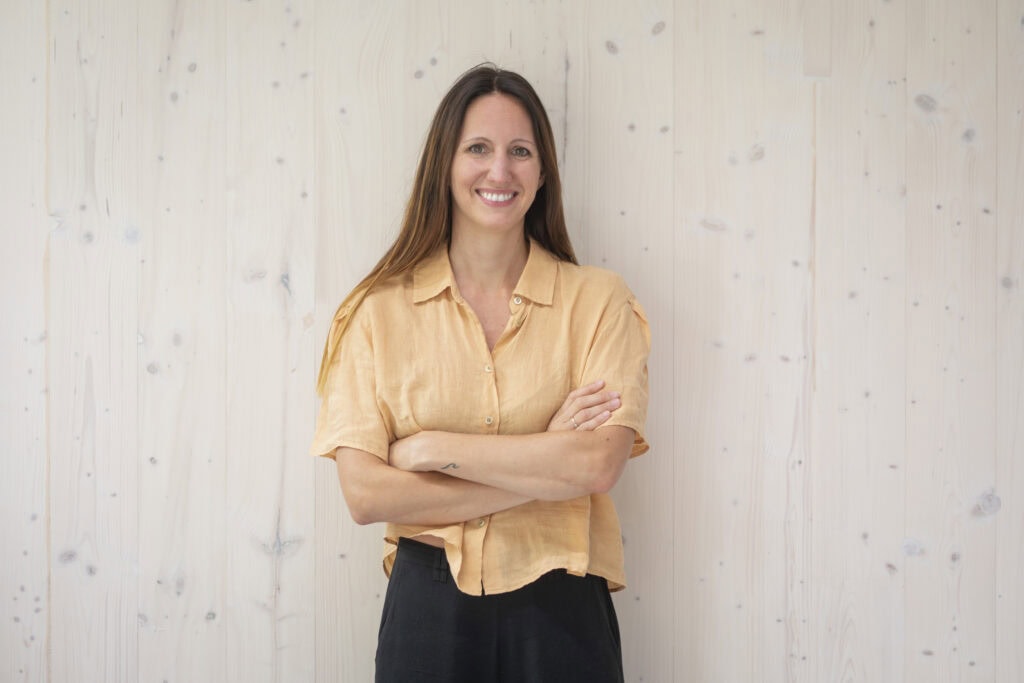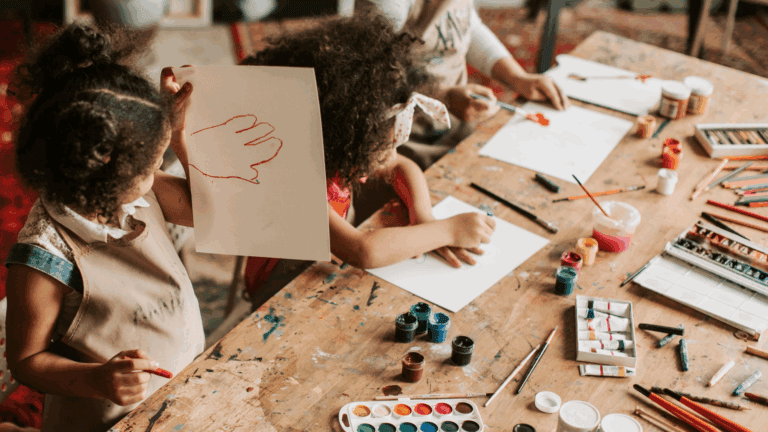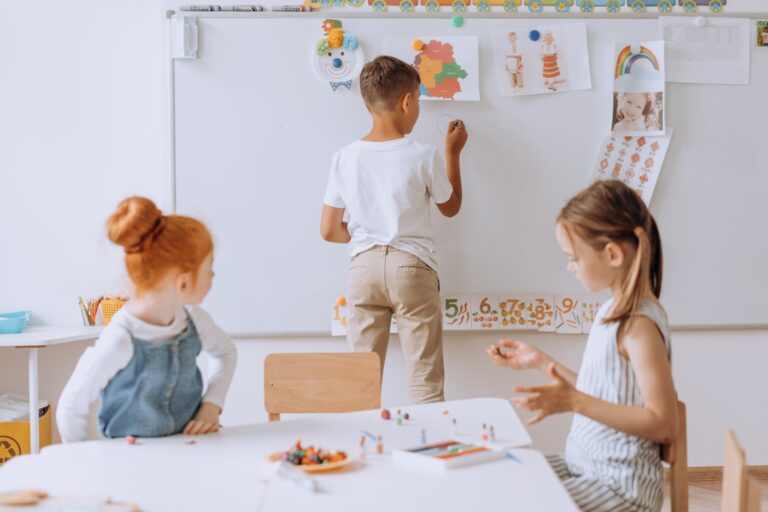Your Child’s Natural Way Of Learning (It’s Not What Traditional Schools Do)
Why we need a different way of learning
In our rapidly evolving world, memorising fixed content becomes increasingly obsolete. What matters is knowing how to learn, how to identify needs, locate resources, experiment boldly, and adapt strategies. Children who learn through real-world engagement and play develop these meta-skills naturally.
They approach new challenges with confidence born from experience. Having taught themselves countless skills through authentic necessity, they trust their ability to master whatever future demands arise. This self-directed learning capacity – far more than any specific knowledge – prepares them for tomorrow’s unknowns.
Learning at Schola Vera is not an educational strategy. It is an acknowledgment of how humans naturally develop competence. By respecting this organic process instead of imposing external structures, we nurture not just academic achievement but the curiosity, resourcefulness, and wisdom children need to flourish as complete human beings.
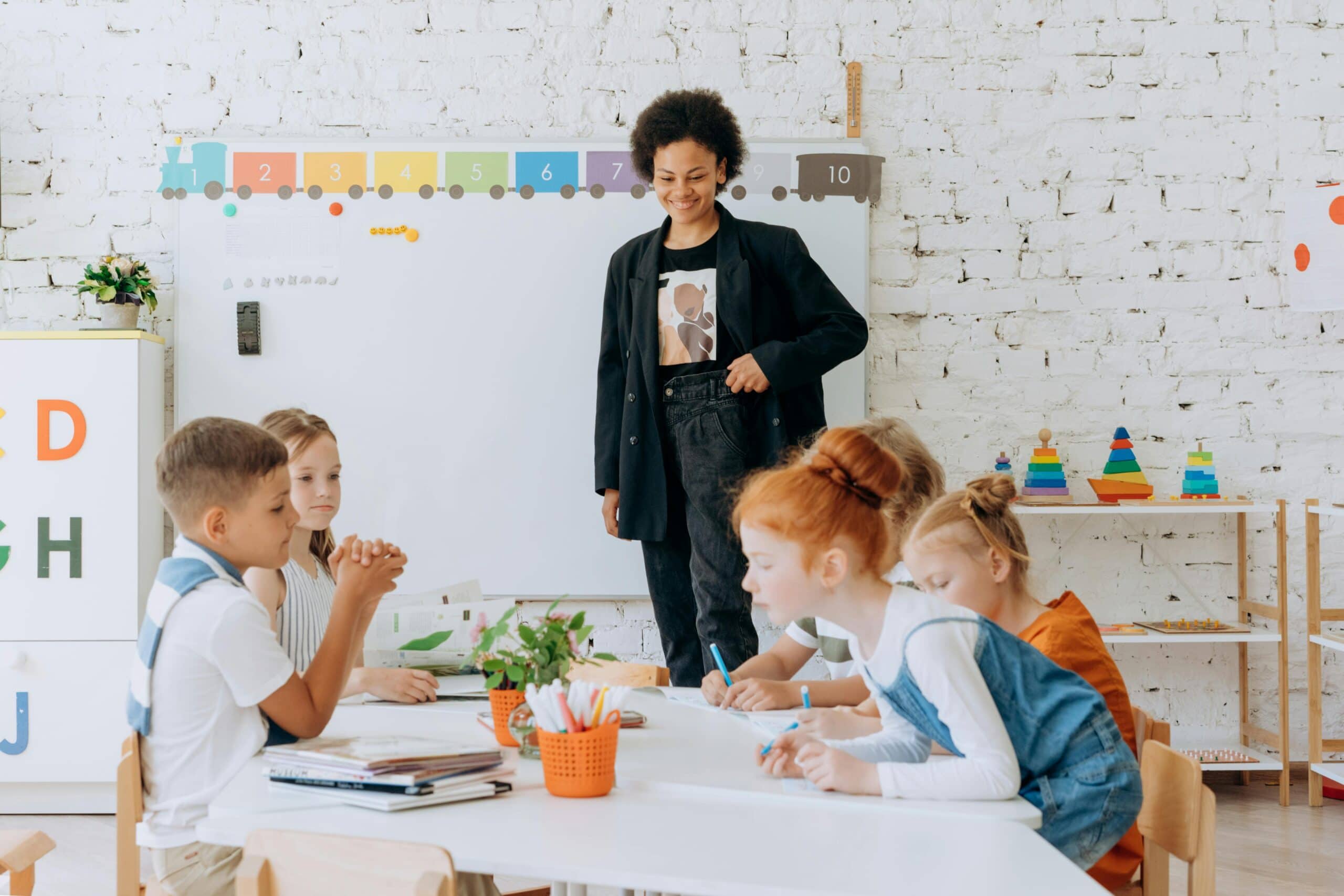
Why we don’t need a standardised curriculum
Traditional schools adhere to standardised curricula, but Schola Vera challenges this approach. Prescriptive learning plans tell only part of the story. Standard curricula consist of boxes to tick: specific lessons, assignments, tests, and learning standards that inevitably restrict genuine learning and creativity. Such rigid structures, designed without children’s input, fail to accommodate the organic, non-linear ways in which children naturally explore and understand the world.
André Stern, author and one of our greatest inspirations, identifies a fundamental problem: adults cannot effectively determine what children should learn because they view the world through adult eyes, not through the eyes of children. When we impose our adult perspectives and priorities on children’s learning, we inevitably miss what truly matters to them in their developmental journey.
We do not conform to curricula. We let our children’s natural curiosity guide their journey.
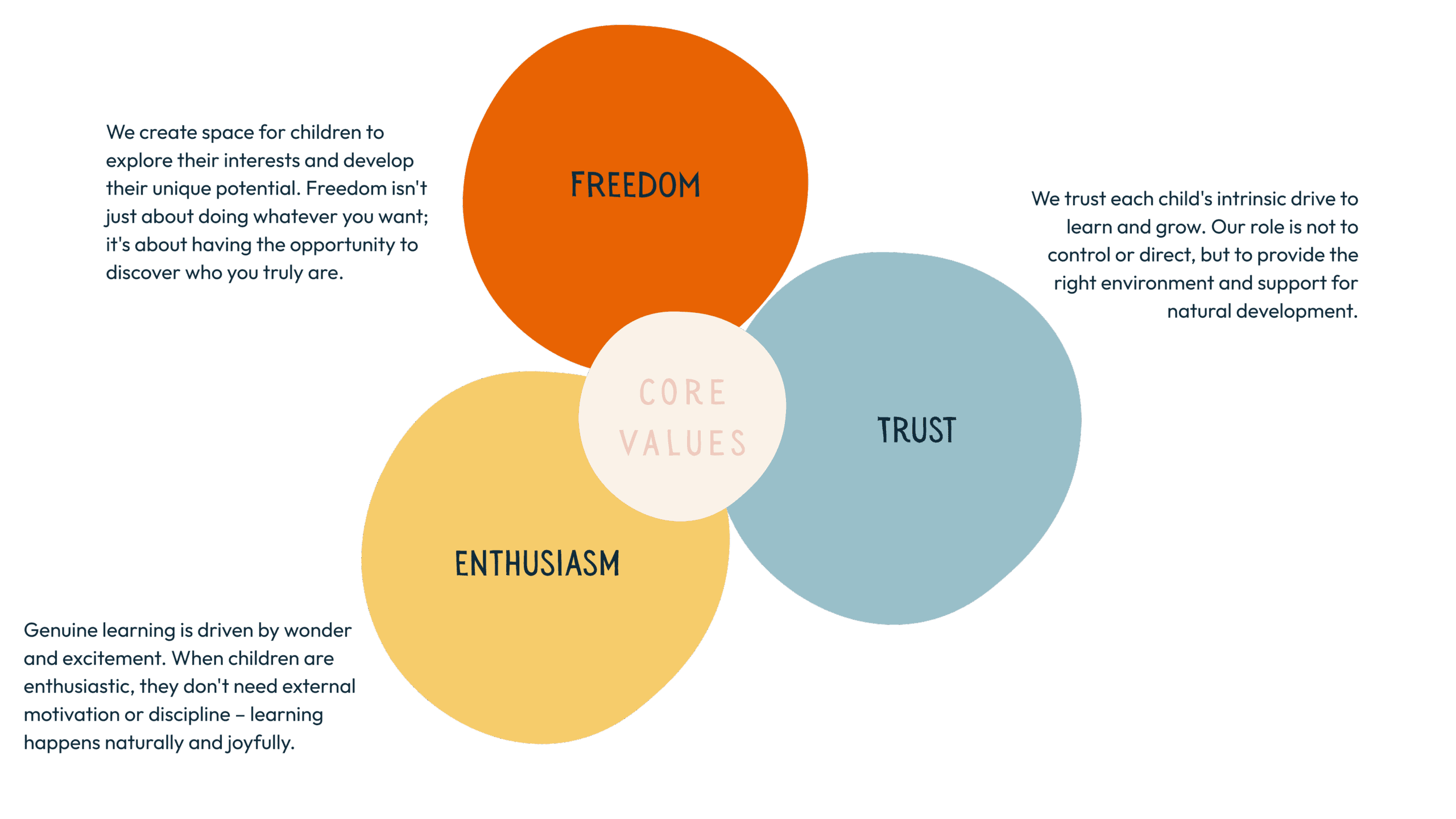
Our approach to learning at Schola Vera
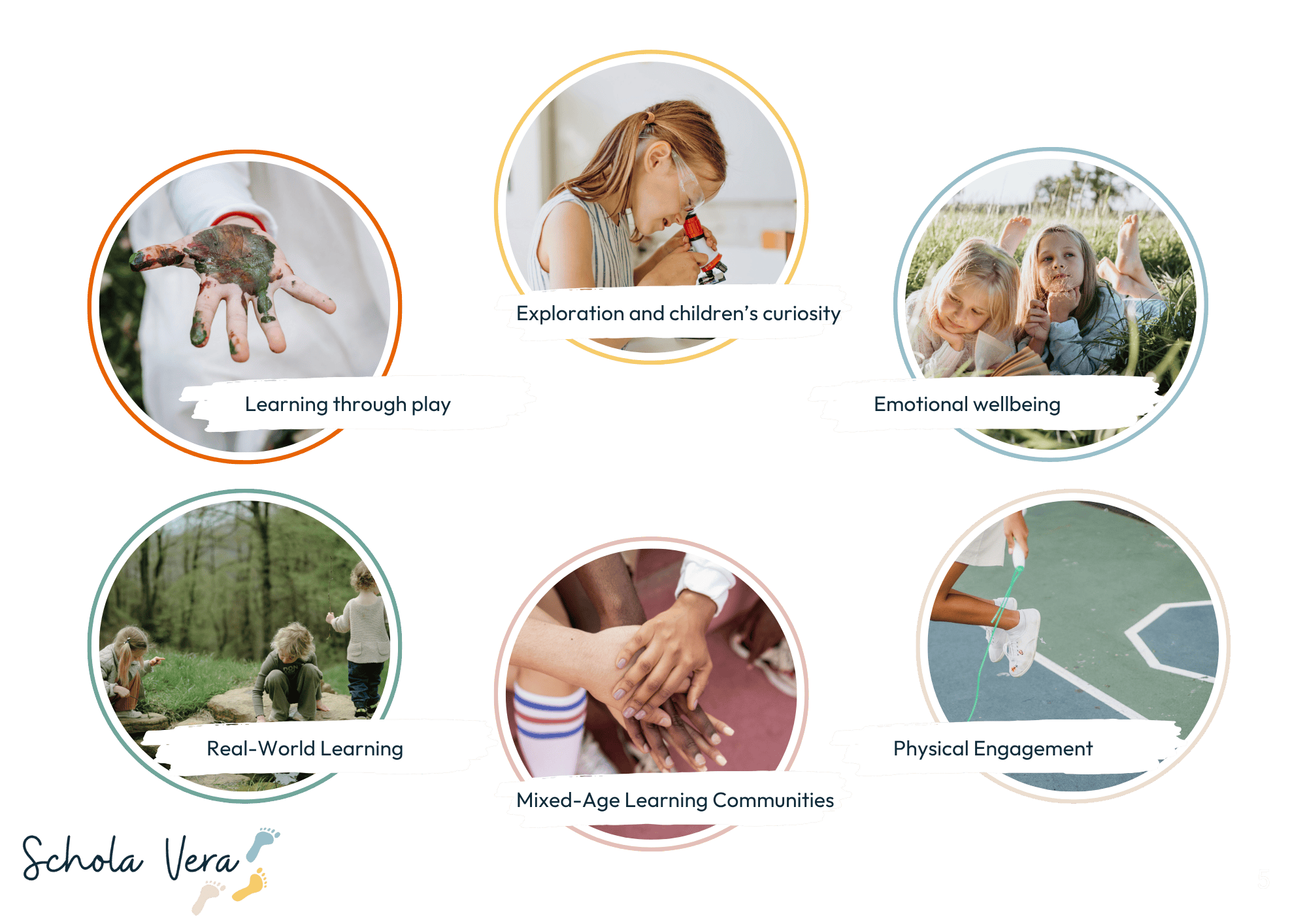
Learning through play
Play is not merely a break from learning. It is learning in its most natural and powerful form. Renowned neuroscientist Gerald Hüther emphasises in his book “Rettet das Spiel” (Save the Play) that play represents the most effective pathway to genuine learning. His research reveals a profound truth: the more adaptable and capable a brain is, the more frequently and intensively it engages in play.
At Schola Vera, we understand play as Hüther describes it: a way to experience aliveness, establish connection, explore one’s own possibilities, and unfold creative potential. This understanding transforms our entire approach to education. When children play, they are not avoiding learning. They are engaging in the deepest form of cognitive, emotional, and social development possible, that is learning.
“Man only plays when he is human in the fullest sense of the word, and he is only completely human when he plays”
Friedrich Schiller
Play: The Foundation of Natural Learning
Through play, children naturally develop the neural pathways essential for complex thinking, problem-solving, and creativity. They learn to navigate social dynamics, test hypotheses, overcome challenges, and discover their own capabilities. All without the artificial constraints of formal instruction. This intrinsic motivation and joy in discovery creates lasting neural connections that forced learning simply cannot achieve.
As Hüther’s research demonstrates, the playful brain is the learning brain. When we allow children to follow their natural inclination toward play, we honour the millions of years of evolution that have shaped this powerful learning mechanism. At Schola Vera, play is not scheduled between lessons. It is woven throughout every aspect of our learning environment, recognising that the distinction between play and learning exists only in traditional educational thinking, not in the reality of how children actually develop and grow.
Our commitment to play-based learning reflects our deeper understanding: that true education nurtures the whole child, preserves natural curiosity, and creates the conditions for authentic, self-directed growth. When children play, they are doing exactly what their developing brains need most: exploring, connecting, creating, and becoming fully human.

Our daily practice
This revolutionary understanding of play reshapes every structural and pedagogical decision at Schola Vera. We begin by fundamentally reconceptualising what happens when children engage in self-chosen activities. Traditional educators might see children building a dam in a stream and think “just playing in water”. We see emerging understanding of hydraulic engineering, cause and effect relationships, collaborative problem-solving, and environmental systems thinking.
Creating space for natural learning rhythms
Our daily rhythm reflects this trust in children’s innate wisdom. We maintain only essential touchpoints – morning gatherings and closing reflections – while leaving the majority of time open for organic exploration. This minimal structure provides security while maximising opportunities for flow states and deep engagement.
Rather than fragmenting the day into subjects or activities, we create an environment where boundaries dissolve naturally.Time spent in the trees might involve complex physical challenges, or it might be spent in quiet observation: watching how leaves dance in different winds, discovering insects living in the bark, or simply experiencing the sensation of being held by branches while listening to the world from a new perspective. We offer resources and possibilities but never impose artificial transitions that would break these natural experiences.
Honouring all forms of engagement
Perhaps most radically, we eliminate value hierarchies among activities. The child who repeatedly climbs the same oak tree – whether developing intricate knowledge of every branch’s strength, practicing the pure joy of coordinated movement, or finding a peaceful refuge for contemplation – contributes as much to our learning community as one conducting formal experiments or creating elaborate artwork. Each child’s chosen focus reflects their unique developmental needs at that precise moment.
This requires adults to step back and resist the urge to direct or interrupt children’s natural learning processes. Maria Montessori for example recognised these moments as opportunities for observation, one of the most important pillars of Montessori pedagogy. When children spend hours perfecting their dam construction, experimenting with different materials, adjusting water flow, rebuilding after failures. We resist the urge to redirect toward more “educational” activities. We recognise these children are conducting sophisticated experiments in physics, developing persistence through trial and error, and experiencing the profound satisfaction of creating something that actually works in the real world.
By removing adult judgments about “productive” versus “unproductive” activities, we create space for children to follow their authentic interests with the intensity and duration necessary for deep learning. A child sitting quietly in a tree, seemingly “doing nothing,” may be processing emotions, developing mindfulness, or simply being present in their body. All essential aspects of human development that no curriculum could schedule or measure.
This trust in children’s self-directed exploration represents perhaps our most significant departure from conventional educational practice and our greatest gift to the children in our care.
“Play is for the child the direct way to connect with everyday life, with themselves, and with the world. For children, free play is a need. A disposition, an inclination, often an urge. It is a deep fulfillment for the child.”
André Stern
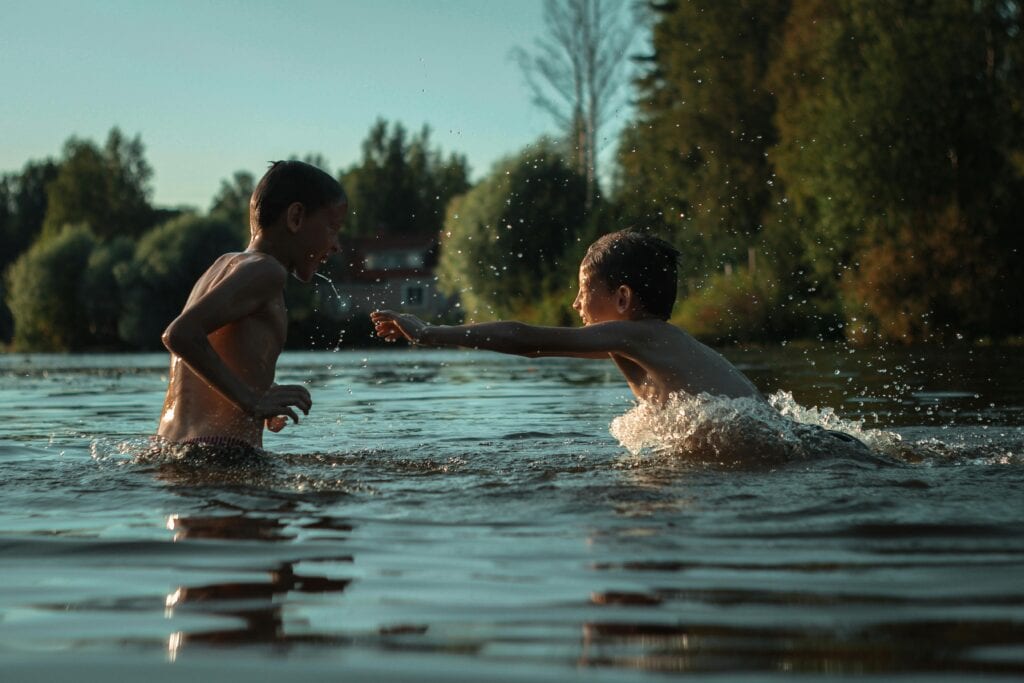
Exploration and children’s natural curiosity
After a decade of implementing inquiry-based learning, Tatiana has witnessed transformations that textbooks simply cannot capture. At Schola Vera, this is not a theoretical framework. It is our daily reality, refined through years of observation and adaptation.
Beyond theory
What sets our approach apart is not just that we allow children’s questions to drive learning. It is the nuanced understanding of how to sustain genuine inquiry. Tatiana has learned through countless hours observing children that true engagement has a distinctive quality: eyes light up, time seems to disappear, and the boundary between work and play dissolves completely.
When a child spent three weeks investigating why leaves change colour, moving seamlessly between microscope observations, artistic representations, and chemical experiments, Tatiana observed something remarkable: authentic inquiry rarely follows a linear path, and the most profound learning often happens in the messy intersections between disciplines.
“The mind that opens to a new idea never returns to its original size.”
Albert Einstein
Learners explore various areas based on their own questions. They are free in terms of their approach and any learning products that may emerge. The focus is on the individual journey, and there is no pressure regarding the development of solutions or learning products.
At first the children’s so-called “big questions” are collected and documented. The research itself is documented and structured by the children themselves. We then discuss various pathways with the children, ensuring they understand the multitude of approaches available for pursuing their investigations. Using visual aids like the “Research Pathways” diagram, we explore methods ranging from observing, experimenting, and measuring to creating, drawing, and inventing. Children are completely free to choose how they approach their research question.
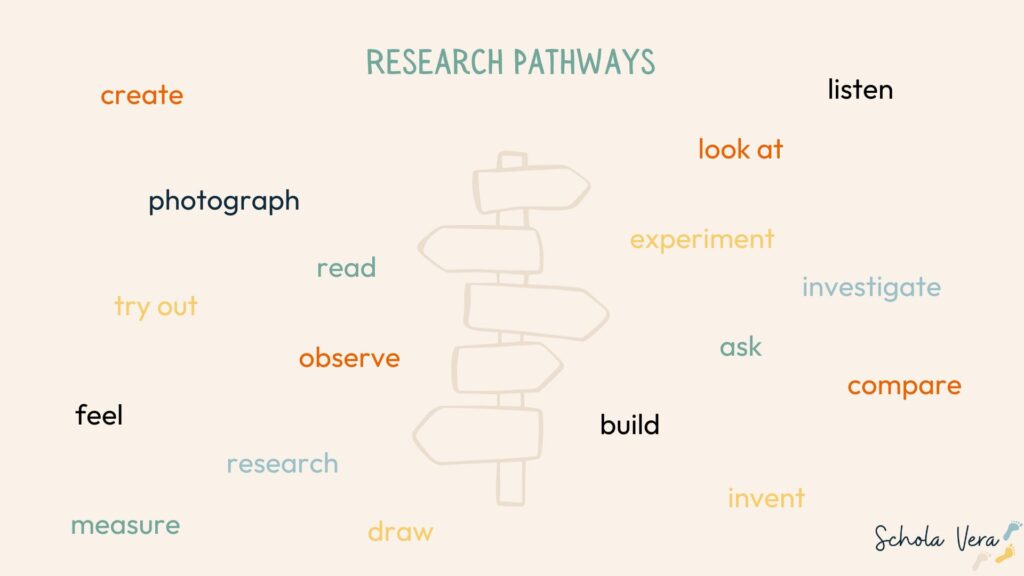
Philosophy as preparation
Before diving into research, we create space for children to wonder and philosophise. Based on the Calvert/Hausberg/Jakobi approach, this philosophical preparation opens children’s minds and hearts for the exploration ahead, a practice Tatiana has refined over many years.
When children philosophise first, they bring their whole selves to their research. They don’t limit themselves to purely scientific thinking but embrace imagination, creativity, and emotional intelligence. This courage to explore big questions – even those without clear answers – transforms their entire journey.
Intrinsic motivation
After years of examining intrinsic motivation in inquiry-based learning settings, we have uncovered fascinating patterns that extend well beyond theoretical frameworks. Working with one of Tatiana’s Master’s students Lynn, we have documented how motivation flourishes under specific conditions, insights drawn not from textbooks but from countless hours observing children in authentic learning environments.
Our classroom experience reveals that motivation emerges from the interplay of three key elements: autonomy, competence experience, and social connectedness.
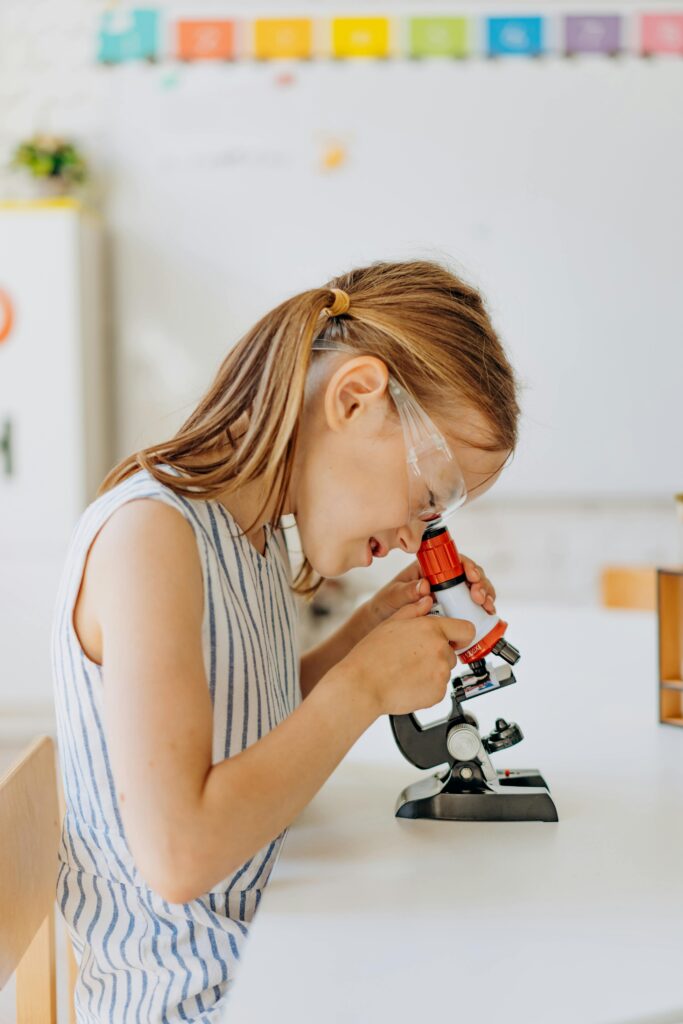
Autonomy
Children naturally seek to express their interests, goals, and values through self-directed exploration. This becomes evident when observing children at free play without prescribed toys or structures – climbing trees, building dams, rolling down hills – all activities characterised by high autonomy with no external guidelines directing or limiting their experience.
What’s remarkable is how this self-chosen exploration leads to a state of flow that we consistently observe during inquiry-based learning. We have documented how children who appear distracted in traditional settings can maintain focused engagement for long periods when pursuing questions that genuinely matter to them.
Competence experience
While traditional education attempts to artificially create appropriate challenge levels through multiple differentiation strategies, these approaches inevitably compartmentalise children into predetermined levels. Our observation confirms that authentic competence experience can only truly emerge in open learning formats like inquiry-based learning.
By removing prescriptive approaches to problem-solving, each child naturally finds their own balance between abilities and challenges. When a project feels “too difficult,” children either seek necessary assistance or adjust their approach to match their capabilities. This responsibility for one’s own competence experience is crucial for learning development and building stable self-esteem.
We have particularly noted how children coming from traditional school settings initially struggle with navigating challenges and dead ends, having grown accustomed to teachers adjusting difficulty levels or solving problems for them.
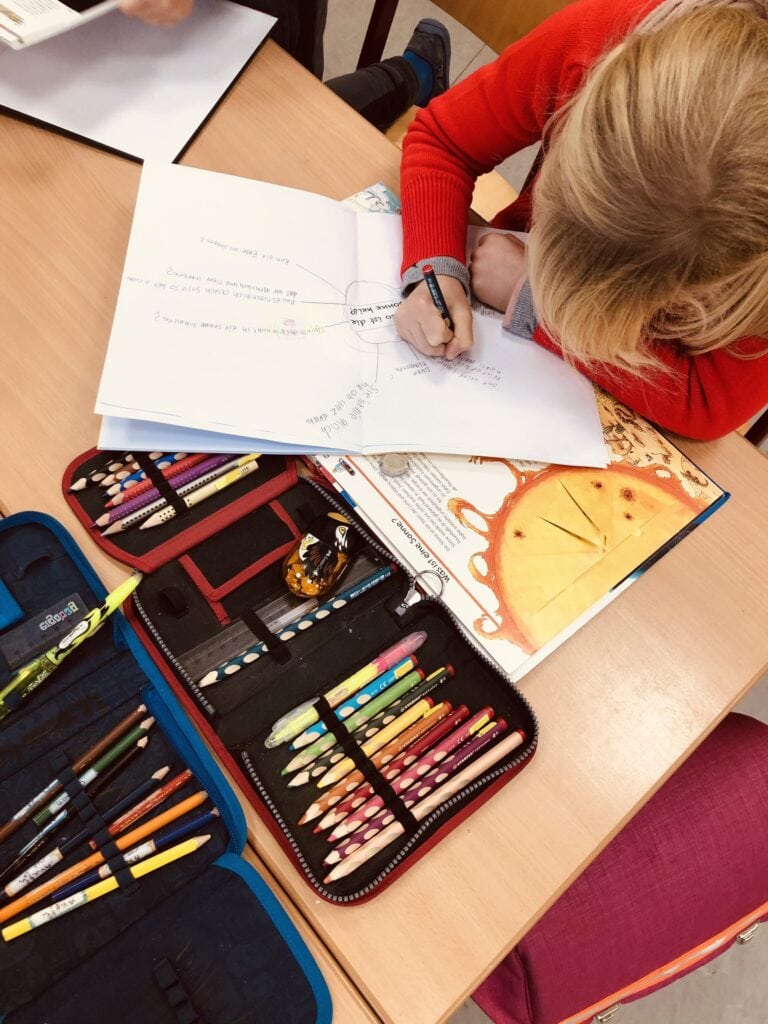
Social connectedness
Children’s need for appreciation and belonging naturally drives them to exchange ideas regularly. Through structured methods like research conferences and reflection circles, children share discoveries, reinforce approaches, and generate new ideas collectively.
One of the most profound shifts we have witnessed repeatedly is how inquiry-based learning transforms classroom dynamics. What begins as the unfortunately common school environment of “comparing and measuring” evolves into a cooperative learning atmosphere of “sharing and collaborating.”
Flow experience: The ultimate indicator
Perhaps most fascinating is observing children in genuine flow states, completely immersed in their research to the point where they merge with their activity. Beyond the many contributing factors, flow experience during research (as in unstructured play) is primarily determined by three central factors:
- Purpose: Since children choose their own questions, they have personally established the purpose of their investigation. This fundamental prerequisite for flow is naturally embedded in inquiry-based learning.
- Clarity about the next step: While not always straightforward, children often need support here – not by prescribing their next move, but by facilitating conversations about their research. At the beginning of each phase, the teacher asks if everyone knows their next step. We utilise research journals where children document progress and plan next steps. Research conferences provide additional support when uncertainty arises.
- Requirements slightly exceeding abilities: When you need only 80% of your abilities to meet a requirement, boredom quickly sets in. Using 80-100% of your abilities may not be boring, but it’s not challenging either. You remain in your comfort zone. At 100-120%, when you’ve chosen the difficulty level yourself, you enter the “flow”. Here, you perform at your best, experiencing growth, happiness, and flow.
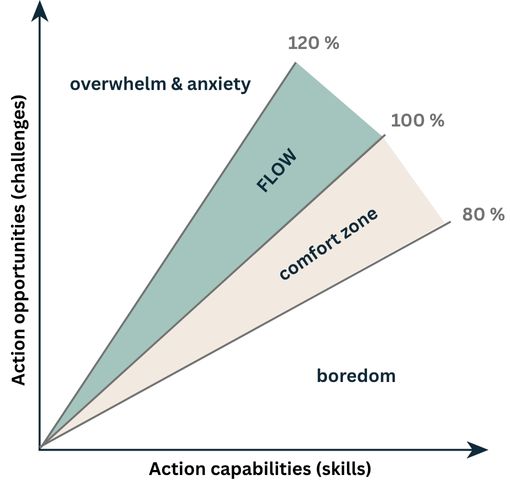
At Schola Vera, these aren’t abstract concepts but daily realities we have documented, analysed, and refined through years of dedicated practice.
“You are so involved in what you’re doing, you aren’t thinking about yourself as separate from the immediate activity. You’re no longer a participant observer, only a participant. You’re moving in harmony with something else you’re part of.”
Csíkszentmihályi Mihály
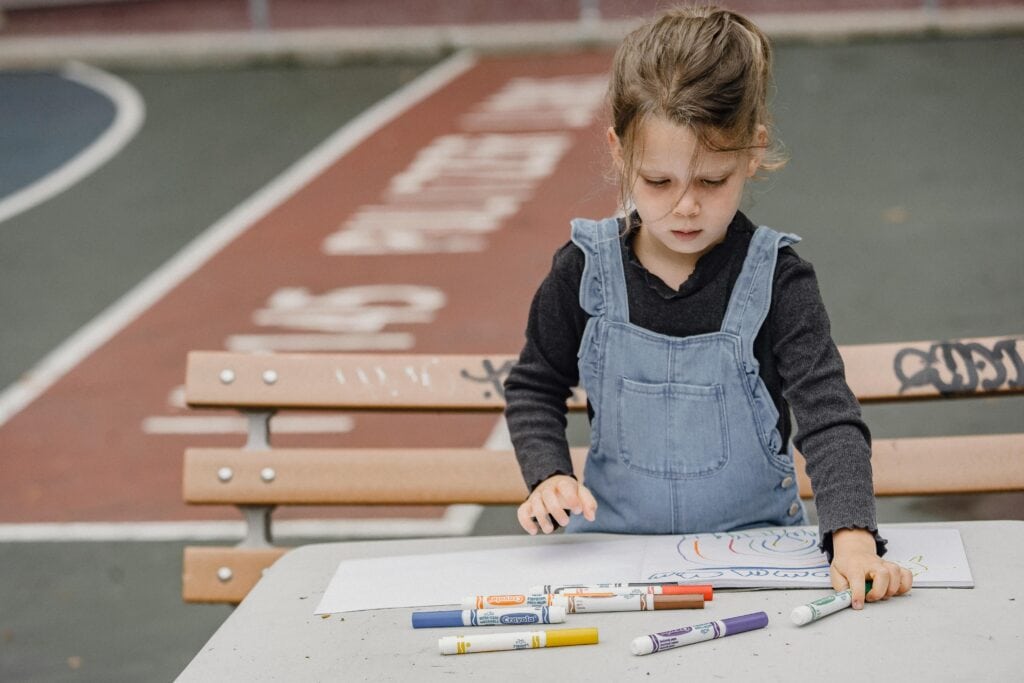
Emotional Well-Being
Throughout her decade as a classroom teacher, Tatiana has witnessed a fundamental truth that traditional education often overlooks: genuine learning cannot happen when children’s emotional needs remain unaddressed. Time and again, she has observed how teachers simply couldn’t begin meaningful academic work until they had addressed the conflicts from the playground, the worries children brought from home, or the emotional burdens they carried into the classroom. Group work and collaboration were only possible in classes with strong social cohesion. A positive learning atmosphere could only be created when children were not exposed to pressure, fear, or competition.
At Schola Vera, emotional well-being is not a supplementary concern or an occasional focus during “social-emotional learning” periods. It forms the very foundation upon which all genuine learning builds. Just as a gardener must prepare the soil before planting seeds, we must nurture emotional security before intellectual growth can flourish.
Neuroscience confirms what we have observed: when children feel stressed, anxious, or emotionally disconnected, their amygdala (emotional centre) overrides the prefrontal cortex (thinking centre), making authentic learning neurologically impossible.
This understanding drives our commitment to creating environments where emotional health is prioritised as the foundation for all cognitive development: without grades, tests, or competitive pressures that create anxiety or fear of failure.
Education the Mind without educating the heart is no education at all.
Aristotle
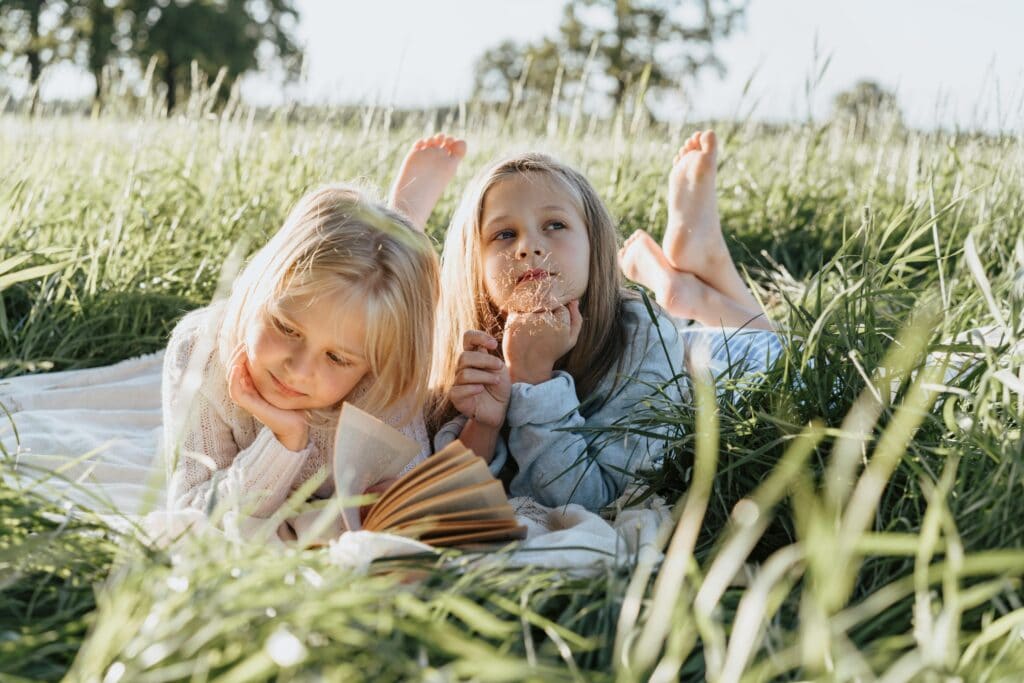
Creating spaces for emotional well-being
At Schola Vera, our approach to emotional well-being permeates every aspect of our daily rhythm and culture. We have developed specific practices that help children develop emotional awareness, regulation skills, and the security necessary for optimal learning.
Our morning circle always includes what we call “weather of feelings”, a ritual Tatiana has refined through years of classroom practice. Every morning, children place their name magnet on different weather cards that represent how they’re feeling. A child might share that they feel “sunny with a few clouds” or “stormy inside.” This visual metaphor helps children identify and express their emotional states. What makes this practice powerful is that there is no judgment about any emotional “weather”. Just like nature’s weather, all emotional states are valid and natural.
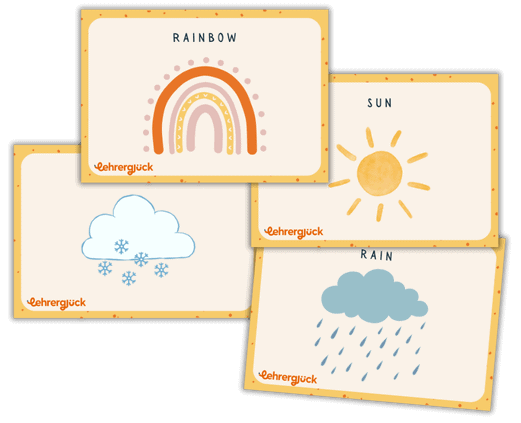
Regular gratitude rituals anchor our community in appreciation. Our happiness jar invites children to capture moments of joy, accomplishment, or gratitude throughout the day. During reflection times, we draw from this jar to celebrate these moments together, reinforcing positive experiences and building emotional resilience.
Every week, we gather in our circle for a ritual we call “Heart and Storm”. This practice serves as a precursor to class council for younger children. Using simple cards – one with a heart and one with a thunderstorm – children take turns sharing what they are grateful for from the week (heart) and what bothered or upset them (storm), then connect their lightning moment with a wish for the future.
Children might say: “My heart moment this week was when…” or “I’m grateful for…” followed by “I was upset when…” and “For next week, I wish that…” This ritual ensures nothing remains unspoken, giving even quieter children space to express themselves. When conflicts are addressed, the wish transforms them into forward-looking, reconciliatory agreements. For instance: “It makes me sad when Paul hides my shoes. I wish he would leave them where they are.” This is not about accusation but about expressing feelings and finding peaceful resolutions.
We integrate mindfulness practices using the Zaphir chime, creating moments of calm whenever we need respite from busy life. During these meditations, children rest their heads on folded arms while one child carries the chime through the room, creating gentle sounds through careful movement. When the sounds stop behind someone’s chair, that child takes over, continuing this peaceful exchange. These sessions often last half an hour, leaving everyone balanced and smiling. A testament to the power of shared stillness.
A culture of emotional expression
Perhaps most importantly, we have cultivated a school culture where emotions are never wrong or inconvenient. Children can express their feelings at any time, whether through words, movement, art, or simply taking space when needed. We model healthy emotional processing by acknowledging all feelings as valuable information about our needs and experiences.
When conflicts arise, we use the principles of Nonviolent Communication, adapted for children through what we call “Giraffe and Wolf Language.” This approach, which Tatiana has successfully implemented in traditional classrooms, helps children express their needs and feelings without blame or judgment. The giraffe represents compassionate communication: being able to say what bothers you without hurting others, expressing feelings openly, and formulating wishes clearly. The wolf represents reactive communication: speaking from anger, making accusations, or saying hurtful things.
Through playful practice and real-life situations, children learn that language has power. It can either escalate conflicts or create understanding. They often begin to “catch” themselves when slipping into “Wolf language”, using the “Giraffe language” to self-correct and clarify situations. This is not about perfect communication but about developing awareness and empathy.
By placing emotional well-being at the centre of our educational approach, we create the secure foundation from which all other learning naturally emerges. When children feel safe to express themselves, supported in their struggles, and valued for who they are rather than what they produce, their natural curiosity and love of learning flourish organically.
Real-World Learning
Life itself becomes our classroom at Schola Vera. We have abandoned the artificial construct of predetermined curricula, because genuine education emerges from authentic experiences, not prescribed lesson plans. We do not fragment knowledge into subjects and schedules. There are no lists of topics children must master, no progression charts marking where they “should” be, no bells dividing learning into artificial chunks.
A child might develop writing skills not because our curriculum demands it, but because they discover personal reasons to write. Perhaps to label their garden plants, compose a letter to a grandparent, or capture the rules of a game they have invented. Mathematics reveals itself through cooking ratios, construction measurements, or dividing treasures fairly among friends. These skills emerge precisely when children need them, making the learning both meaningful and lasting.
The principal Goal of Education Should Be Creating Men and Women who are capable of doing new things, not simpy repeating what other Generations have done.
Jean Piaget
In the garden
Our vegetable garden illuminates this approach beautifully. What begins as planting seeds unfolds into rich, multifaceted learning:
- Geometry emerges through plot design and spacing calculations
- Biology reveals itself through growth cycles and composting systems
- Economics develops through harvest pricing and market negotiations
- Writing skills grow through seed labels and sales signs
- Problem-solving intensifies when pests appear or weather shifts unexpectedly
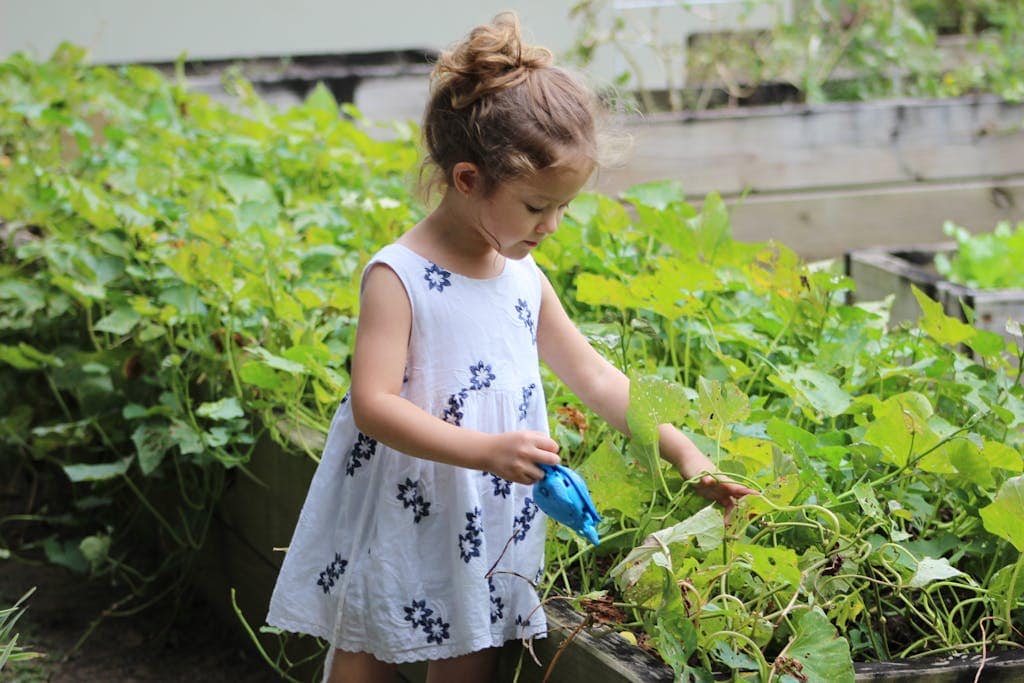
We never force these connections. Children discover them naturally as they engage with real challenges that matter to them.
Integration over isolation
When children construct a fort, they are not switching between “maths class” and “physics class” and “art class.” They are solving integrated challenges: calculating angles while considering aesthetics, testing weight limits while preserving beauty, negotiating design choices while maintaining structural integrity.
This mirrors how knowledge actually functions outside school walls. Chefs blend chemistry with artistry. Engineers merge mathematics with creativity. Writers combine research with imagination. By learning through unified experiences, children develop intellectual flexibility that serves them throughout life.
Trusting the Process
Our approach demands courage. The courage to trust that children will acquire necessary skills through authentic engagement rather than forced instruction. This trust proves justified daily as we observe:
- A child mapping water flow patterns developing sophisticated understanding of physics
- Another organising a puppet show mastering narrative structure and project management
- Someone trading garden produce for art supplies grasping economic principles intuitively
Each child’s path looks different, yet all develop robust capabilities through pursuing their genuine interests with dedication.
Mixed-age learning communities
In the real world, we never just interact with people exactly our own age. This artificial age segregation is unique to conventional schooling and doesn’t reflect how humans naturally learn and socialise. At Schola Vera, children learn from and with each other in more natural, mixed-age groups that mirror the diversity of real human communities.
The social reality beyond school
As adults, our most meaningful relationships are built on the unique qualities each person brings. We find inspiration in others’ different perspectives, learn from varied life experiences, and thrive in communities where diversity of thought, background, and approach enriches every interaction.
Mixed-age learning environments provide daily practice in navigating these authentic human relationships. Children develop the social confidence they will need throughout life: communicating across developmental stages, offering help appropriately, seeking guidance from diverse sources, and valuing contributions regardless of age.
Children as natural social beings
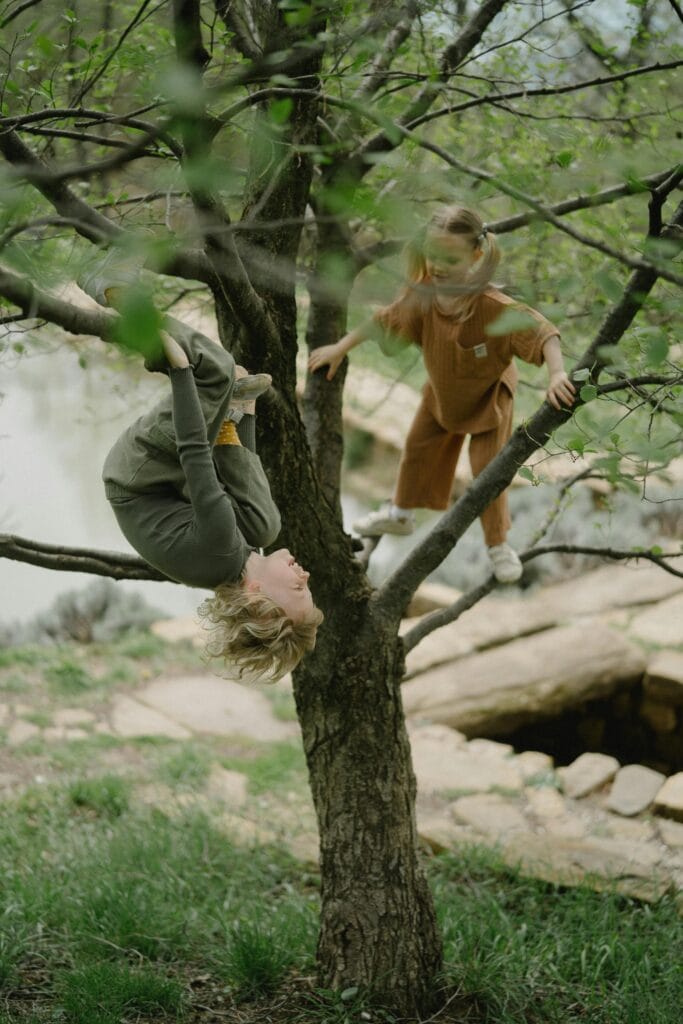
Children enter the world without artificial hierarchies. They don’t see divisions between subjects and professions. Pottery and mathematics hold equal fascination, window cleaners and astronauts inspire equal wonder. They don’t segregate activities by gender or rank learning by importance. For children, learning is learning, people are people, and connection happens naturally.
This innate openness represents humanity at its finest. Before adults teach them otherwise, children embody tolerance naturally. An eight-year-old doesn’t judge a four-year-old’s approach to problem-solving; they simply observe, offer gentle guidance, and celebrate different ways of discovering. By preserving these natural social instincts, we nurture children who grow into adults capable of building inclusive, collaborative societies.
The pedagogical transformation
When Tatiana first became a class teacher of a mixed-age group, she experienced a profound pedagogical shift. Traditional differentiation strategies – creating multiple worksheets for different ability levels, organising students into achievement groups, planning lessons with various complexity tiers – simply didn’t work in an authentically mixed-age environment.
This challenge revealed education’s greatest opportunity. Mixed-age learning automatically dismantles the artificial construct of “levels” that dominates conventional education. At Schola Vera, there are no prescribed tasks because children seek their own challenges; there are no predetermined expectations because each individual child sets their own goals; there are no levelled materials because the world itself isn’t divided into artificial stages.
The world doesn’t present itself in neat difficulty levels. A tree doesn’t offer “beginner branches” and “advanced branches”. It simply exists, inviting each child to engage at their own level of capability and interest. Our learning materials and opportunities follow this same principle.
Help Flow: Community through contribution
At Schola Vera, our Help Flow enables children to support one another naturally. Children with questions can turn not only to teachers and guides but also to peers across age groups. A seven-year-old who has mastered tying shoes becomes a teacher for younger children struggling with laces. A ten-year-old passionate about insects shares expertise with anyone curious about their latest discovery.
This transforms learning support entirely. Instead of always seeking adult answers, children develop confidence in multiple sources of help and, crucially, discover the joy of offering their own knowledge and skills when others need them.

Benefits of a Help Flow for the learning community
Community bonds strengthen organically. When children regularly help and receive help from one another, relationships deepen into genuine interdependence. They see themselves as part of a learning ecosystem where everyone contributes.
Competition dissolves into collaboration. A twelve-year-old isn’t competing with a seven-year-old; they’re collaborating, each contributing unique perspectives and capabilities.
Authentic self-confidence develops. Nothing builds genuine self-esteem like successfully helping another person learn. Children experience being both teachers and students, developing balanced confidence rooted in contribution.
Responsibility emerges naturally. Children take ownership not just of their own learning but of their community’s wellbeing. They notice needs, offer assistance unprompted, and care for shared spaces.
Cognitive flexibility grows. Close contact with various ages and developmental stages provides insight into different ways of thinking, processing information, and approaching challenges. Skills that serve them throughout life.
The bigger picture
At Schola Vera, mixed-age learning communities represent the world we want our children to create. When children experience daily life in diverse, mutually supportive communities where everyone’s contributions matter, they’re prepared to create societies characterised by collaboration rather than competition, inclusion rather than segregation, and wisdom drawn from all generations.
By embracing mixed-age learning, we’re nurturing the future leaders, collaborators, and community builders our world desperately needs.
Movement and physical engagement
Watch any young child and you’ll see it immediately: they learn through their whole bodies. They explore the world by touching, climbing, dancing, and moving. This isn’t restlessness or distraction. It’s exactly how children are designed to learn.
At Schola Vera, we honour this natural wisdom. Children aren’t expected to sit still for hours, fighting against their biology. Instead, movement flows through their learning experience as naturally as breathing. We understand that the impulse to move isn’t something to suppress; it’s the very foundation of how deep, lasting learning happens.
Playing with all senses
Maria Montessori recognised that children learn through their entire sensory system. An understanding that aligns beautifully with our observations at Schola Vera. When children explore mathematical concepts through building, their hands understand weight and balance whilst their minds grasp numerical relationships. When they learn about plant cycles by actually gardening, their bodies experience growth rhythms that textbooks cannot convey.
Children’s bodies are designed for movement, and long periods of sitting simply don’t align with their natural energy and learning patterns. Growing bodies need varied movement and different positions to develop healthily: strengthening muscles, supporting proper posture, and maintaining physical well-being. Research shows that even brief physical activity can enhance attention and learning capacity for hours.
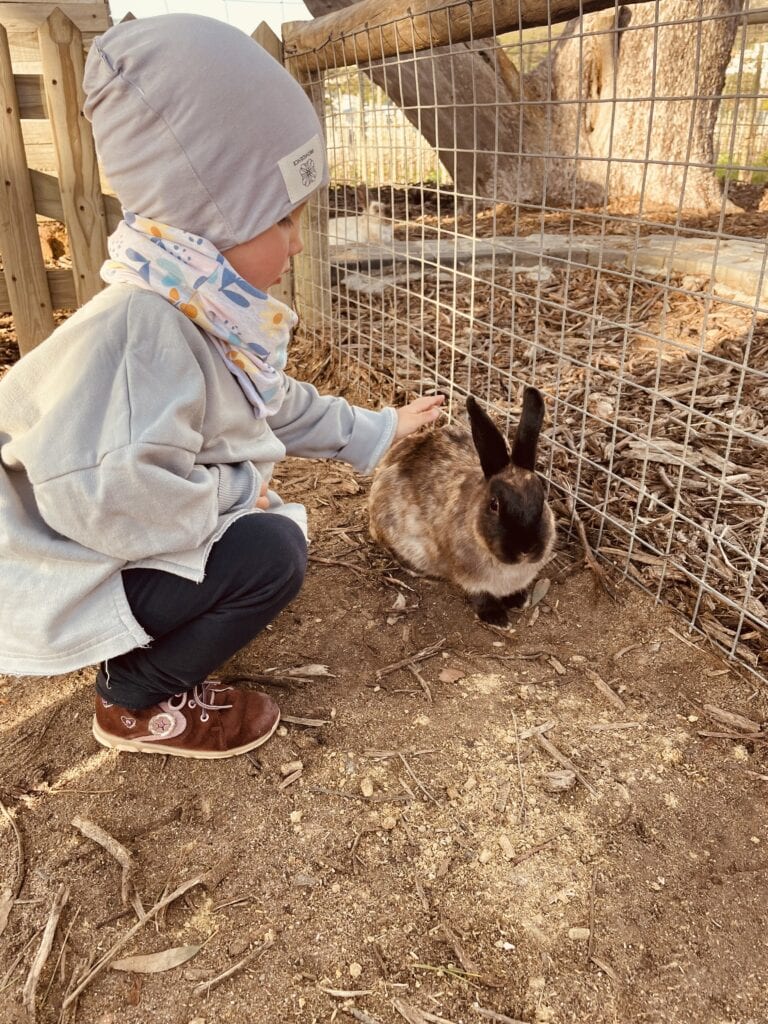
At Schola Vera, we design learning environments that honour children’s natural need for movement and connection to the outdoors. We create spaces that invite exploration rather than restrict it, trusting that when children’s physical needs are met, learning happens naturally.
Honouring natural rhythms
We don’t prescribe where children should play and learn. Every child has unique sensory needs and physical requirements that change throughout the day. Rather than imposing uniform positions, we create diverse settings:
Indoor options: Flexible seating arrangements, alternative learning surfaces like benches and cushioned floor areas, standing spaces, and quiet retreats
Outdoor environments: Natural hideaways amongst trees, elevated perspectives in tree houses, comfortable gathering spots with hammocks and blankets, and open movement areas
Movement isn’t scheduled separately. It’s seamlessly woven throughout every experience:
The child who has to sit still listening to a teacher is in the worst possible state of mind and body for learning.
Dr. MariA Montessori
Children naturally move as they play and explore. They climb trees to reach the perfect reading spot, run between discoveries in the garden, build elaborate structures that require lifting and balancing, dance to music that moves them, and tumble across grass while lost in imaginative games.
At Schola Vera, movement and learning are integrated aspects of the same natural process, supporting the whole child whilst preparing them for lives of health, creativity, and embodied wisdom.
Living our curriculum at Schola Vera: The learning environment in practice
How do we translate our curriculum philosophy into daily reality? Since ours is a curriculum without prescribed content, we can instead describe the rhythms and rituals that shape our days. Here, we paint a picture of the learning atmosphere that surrounds all our actions, play, and discovery.
Rather than rigid timetables or subject divisions, we create a living environment where natural learning unfolds through carefully crafted rhythms, thoughtfully designed spaces, and authentic relationships.
Daily rhythms
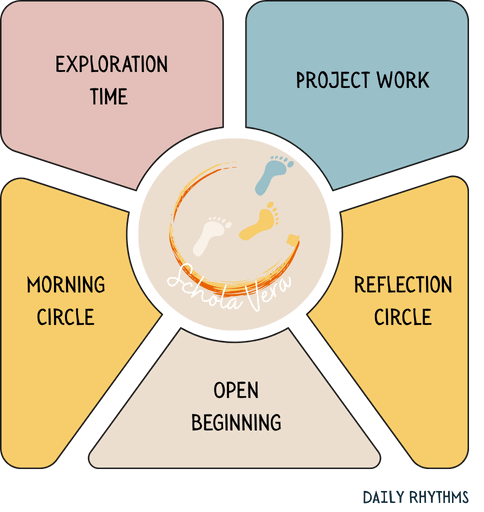
Open beginning: arriving as whole beings
Our day begins with an open welcome. A start that allows each child to arrive and unfold in their own rhythm and tempo. Some children prefer to ease gently into their day with a quiet book or collecting stones in the garden. Others burst forth with creative energy, diving immediately into art or construction projects. Still others thrive on social connection, gathering friends for climbing adventures, conversations, or ball games. Only through this open beginning can we truly honour such beautiful diversity.
Picture this scene at Schola Vera: Two girls practice gymnastic moves they learned yesterday whilst several children gather around to watch. A group clusters around one child’s Harry Potter drawings, deep in animated discussion about characters and plot twists. Some children sit outdoors enjoying breakfast, their laughter and conversation creating a warm backdrop. Others write new research ideas in their inquiry journals, capturing inspiration before it fades.
This organic arrival pattern ensures that each child begins their day feeling seen, valued, and free to be authentically themselves.
Morning circle: weaving community through connection
When the natural arrival energy settles, we gather in our morning circle. Not because a bell demands it, but because we sense the group’s readiness for connection. Children themselves facilitate this gathering, taking turns to lead discussions about weather observations, share current projects, or introduce new interests they wish to explore.
Our circle includes our “weather of feelings” ritual, where children place their names beside weather symbols representing their inner landscape: sunny, cloudy, stormy, or anything in between. This practice validates all emotional states whilst building vocabulary for inner experiences. We close our circle with music and a gentle overview of possibilities for the day ahead, ensuring everyone feels oriented and excited about the hours to come.
Open exploration time: following children’s questions
During our longest daily period, children pursue whatever genuinely interests them. Some might follow significant questions across all areas of life what we might call inquiry-based learning in its most natural form. But we never require children to “research” or force them to invent questions when none exist naturally. This exploration time is simply one of many ways children can engage with their world through play.
We don’t separate “research” from other forms of play or suggest that investigation is more valuable than imagination, building, climbing, or quiet contemplation. At its heart, research is simply one of many ways children naturally play, following curiosity wherever it leads.
Children move freely between indoor and outdoor spaces, choosing environments that support their current interests. They decide how to structure their time, what activities call to them, and when they need collaboration versus solitude.
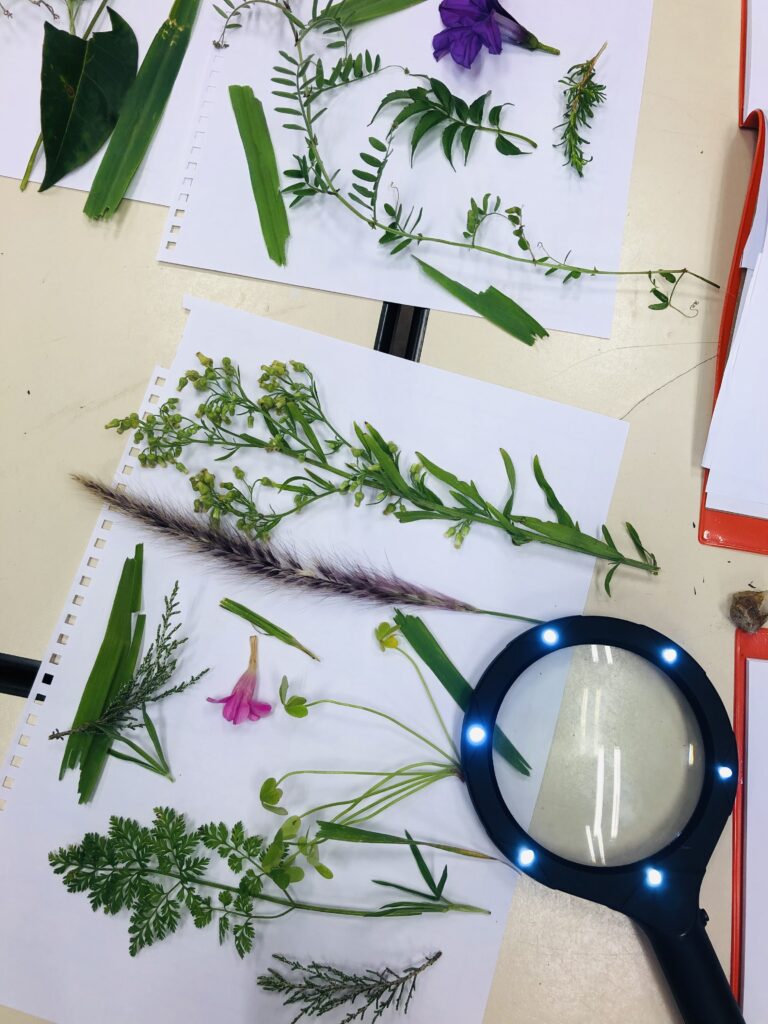
The role of adults shifts fundamentally: instead of directing learning, we observe closely, ask thoughtful questions when appropriate, and provide resources when requested.
Project work: community learning in action
Several times each week, we offer thematic projects that invite collaborative exploration. These are not predetermined curricula but emerge from the community’s genuine interests and needs. Children are always free to choose whether a project appeals to them. Participation is never mandatory, only offered when genuine interest exists.
Imagine we are creating a reading corner together. This authentic project integrates countless learning opportunities for those who choose to participate: children measure spaces for comfortable seating, choose and arrange books by topics they find interesting, design simple labels and signs, create a peaceful atmosphere with cushions and natural decorations, and decide together how to care for and organise our shared book collection.
Reflection circle: integrating the day’s discoveries
Before departing, we gather once more to share discoveries, consolidate learning, and appreciate both individual and collective growth. Children might demonstrate a new skill they have developed, share an exciting discovery from their research, or reflect on moments of joy or challenge from their day.
The learning environment
Our physical environment reflects our educational philosophy in every detail. Instead of rigid rows of desks, we create flexible spaces that adapt to children’s natural movements and learning preferences. Examples of such spaces might include:
Indoor spaces:
Outdoor classrooms:
Children flow naturally between these environments, choosing spaces that support their current needs and interests.
Materials that inspire authentic exploration
We choose our learning materials thoughtfully. Everything available to children serves genuine learning purposes whilst maintaining beauty and connection to the natural world.
Technology integration
When technology serves authentic purposes, we embrace it. Children might use tablets to research migration patterns of butterflies they’re observing, create stop-motion films documenting plant growth, or video-call with experts who can answer their questions. Technology becomes a tool in service of curiosity rather than entertainment or distraction.
Relationships and rhythms
Beyond physical spaces and materials, the most crucial element of our learning atmosphere remains invisible: the quality of relationships and interactions that occur throughout each day.
Every interaction builds on fundamental trust in children’s inherent goodness and capability. When adults consistently demonstrate belief in children’s natural desire to learn and grow, this trust becomes the invisible foundation supporting all exploration and discovery. Our daily rhythms provide security whilst maintaining flexibility. Children know what to expect whilst understanding that the specific content emerges from their interests and needs. This rhythm over rigidity creates the predictable framework within which genuine freedom can flourish.
Ready to Give Your Child the Education That Changes Everything?
At Schola Vera, we don’t just talk about natural learning. We live it every day. Our curriculum isn’t a collection of subjects to be mastered or boxes to be ticked. It’s a carefully crafted environment where your child’s innate curiosity, creativity, and joy can flourish without the pressure of grades, tests, or standardised expectations.
When children learn through play, follow their genuine interests, and develop within supportive mixed-age communities, something remarkable happens: they don’t just acquire knowledge. They fall in love with learning itself. They develop the confidence, resilience, and self-direction that will serve them throughout their lives, whatever path they choose.
This is what education can be when we trust children’s natural wisdom and create the conditions for authentic growth. This is what will change everything for your child.
